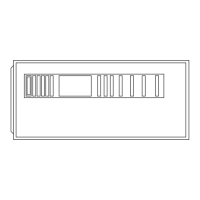20
115--V W
iring
Verify that the voltage, frequency, and phase correspond to that
specified on unit rating plate. Also, check to be sure that service
provided by utility is sufficient to handle load imposed by this
equipment. Refer to rating plate or Table 7 for equipment
electrical specifications.
U.S. Installations: Make all electrical connections in accordance
with National Electrical Code (NEC) ANSI/NFPA 70 --2006 and
any local codes or ordinances that might apply.
Canadian Installations: Make all electrical connections in
accordance with Canadian Electrical Code CSA C22.1 or
authorities having jurisdiction.
FIRE HAZARD
Failure to follow this warning could result in personal
injury, death, or property damage.
Do not connect aluminum wire between disconnect
switch and furnace. Use only copper wire.
!
WARNING
Use a separate, fused branch electrical circuit with a properly
sized fuse or circuit breaker for this furnace. See Table 7 for wire
size and fuse specifications. A readily accessible means of
electrical disconnect must be located within sight of the furnace.
Table 7 – Electrical Data
FURNACE
SIZE
V O LT S ---
H E R T Z ---
PHASE
OPERATING
VOLTAGE RANGE
MAX. UNIT
AMPS
UNIT
AMPACITY
#
MAX . WIRE
L E N G T H --- F T ( M ) }
MAX . FUSE OR
CKT BKR AMPS {
MIN.
WIRE
GAUGE
Max. Min.
070--- 12/ 036070 1 1 5 --- 6 0 --- 1 127 104 9.0 11.99 30 (9.0) 15 14
090--- 16/ 048090 1 1 5 --- 6 0 --- 1 127 104 9.6 12.56 29 (8.8) 15 14
110--- 20/ 060110 1 1 5 --- 6 0 --- 1 127 104 15.1 19.33 29 (8.8) 20 12
135--- 22/ 066135 1 1 5 --- 6 0 --- 1 127 104 14.9 19.13 30 (9.0) 20 12
155--- 22/ 066155 1 1 5 --- 6 0 --- 1 127 104 15.0 19.23 29 (8.8) 20 12
* Permissible limits of the voltage range at which the unit operates satisfactorily .
# Unit ampacity = 125 percent of largest operating component’s full load amps plus 100 percent of all other potential operating components’ (EAC, humidifier,
etc.) full load amps.
{Time---delay type is recommended.
}Length shown is as measured 1 way along wire path between furnace and service panel for maximum 2 percent voltage drop.
NOTE: Proper polarity must be maintained for 115-- v wiring. If
polarity is incorrect, control LED status indicator light will flash
rapidly and furnace will NOT operate.
J--Box
Relocation
NOTE: If factory location of J--Box is acceptable, go to next
section (ELECTRICAL CONNECTION to J--Box).
NOTE: On 14-- in. (356 mm) wide casing models, the J--Box
shall not be relocated to other side of furnace casing when the
vent pipe is routed within the casing.
1. Remove and save two screws holding J--Box. (See Fig.
24.)
NOTE: The J-- Box cover need not be removed from the J-- Box
in order to move the J-- Box. Do NOT remove green ground
screw inside J --Box. The ground screw is not threaded into the
casing flange and can be lifted out of the clearance hole in casing
while swinging the front edge of the J--Box outboard of the
casing.
2. Cut wire tie on loop in furnace wires attached to J--Box.
3. Move J--Box to desired location.
4. Fasten J--Box to casing with the two screws removed in
Step 1.
5. Route J--Box wires within furnace away from sharp edges,
rotating parts and hot surfaces.
Electrical Connection to
J--Box
Field--Supplied Electrical Box on Furnace J--Box Bracket
See Fig. 25.
1. Remove cover from furnace J--Box.
2. Attach electrical box to furnace J--Box bracket with at least
two field-- supplied screws through holes in electrical box
into holes in bracket. Use blunt--nose screws that will not
pierce wire insulation.
3. Route furnace power wires through holes in electrical box
and J--Box bracket, and make field--wire connections in
electrical box. Use best practices (NEC in U.S. and CSA
C22.1 in Canada) for wire bushings, strain relief, etc.
4. Route and secure field ground wire to green ground screw
on J--Box bracket.
5. Connect line voltage leads as shown in Fig. 25.
6. Reinstall cover to J-- Box. Do not pinch wires between
cover and bracket.
Electrical Box on Furnace Casing Side
See Fig. 25.
See Fig. 24.
58CV

